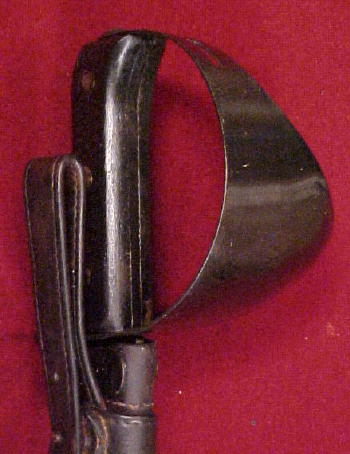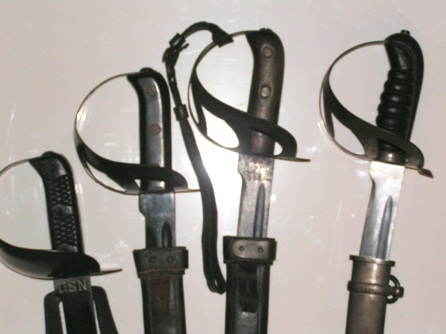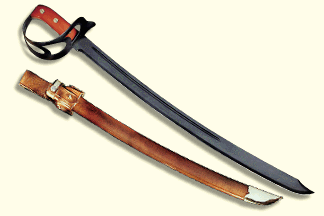and Variants

Cutlasses are among my favorite swords. They all have the appearance of what one envisions as a "buccaneer's" or "pirate's" main weapon; the imagination runs wild.
To the left is a very close copy of the regulation
US Model 1917 Naval Cutlass, the last regulation pattern for the US Navy
(see below).
This pattern sword replaced the US Model 1861
Naval Cutlass).
The hilt is of a half-cup design, sheet-steel construction. One this example,
the metal furniture is nickel-plated, as if for a special unit (such as
Honor Guard) or guard, and would have been privately purchased. The grip is of
hard-plastic*, black in color, with a knurled pattern on the side panels; grips
are held in place by three recessed nut-screw sets. Cup and hilt and held onto
blade by a single screw (butt of pommel).
Stainless-steel blade is ~24" in length, curved, and of clip-point style with
~2-1/2 false-edge, ~24-1/2" cutting-edge. Single-fuller - both sides - is ~14"
in length.
Markings on the blade ricasso are: right side - U.S.N.; left side - "knight's
head" over "WKC" (Weyersberg, Kirschbaum & Company) over "SOLINGEN" over
"STAINLESS".
These variants are extremely well-made and functional.
* The term "plastic" is used in a generic sense, and not to be considered
verbatim.
'BAKELITE' - a phenolic - was invented in 1909 and quickly used by the
military in a variety of applications. Variant phenolics were in wide use
throughout the US military from 1935 to about the mid-1950s; at that point,
a new process using polystyrene became the material and method of choice,
especially for edged-weapon grips. This polystyrene material is in use to
this day in numerous military applications, and I am sure there are further
improvements - of which I am not aware at this time - but such is the nature
of advances in technology. The bottom line is this - phenolics/plastics/polystyrene
are all the same for quick identification/reference. It would serve no purpose - to the novice
collector - to state "this cutlass has a black BAKELITE phenolic grip, or
perhaps a black PLASTIC phenolic/polystyrene grip."
Haven seen early 1917 cutlasses with damaged grips, I would categorize them
as having black BAKELITE grips, but that means absolutely nothing to the novice
collector when the material appears more like a black HARD-PLASTIC.






